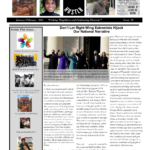Dr. Yomi Noibi
Lynn Young
Environmental Community Action
ECO-Action visionary leadership has empowered the community-driven development in the Historic Westside English Avenue and Vine City communities. Their community-driven development approach embraced the assets within community and increased the community capacity to define their issues and to design and implement corrective solutions. Abstract of the Healthy Homes and Resident Retention study has been selected for inclusion in the Atlanta Clinical Translational Science Institute (ACTSI) annual conference “Understanding Resilience in Underserved Communities: From Research to Reality” on April 27th and 28th. .
From Research to Reality, a Community Driven Approach
The Historic Westside and other underserved urban centers throughout the United States often are not viewed externally as resilient, innovative or resourceful asset based communities with the capacity for sustainable change. This is an unfortunate hindrance to building a Beloved Community where people recognize that we are all interconnected; that our individual well-being is inextricably linked to the well-being of others. As advocates for this realization, it is of great significance when a community successfully drives efforts to evaluate and address the quality of life issues confronting it. It is even more relevant when their like-minded partners demonstrate qualitative and quantitative shifts in their approach to community engagement.
Such was the case in the fall of 2014, when ECO-Action collaborated with West Atlanta Watershed Alliance, Proctor Creek Stewardship Council, and Community Improvement Association, community organizations and Emory University’s Department of Public Health to conduct a survey of 150 homes. Some of these homes had experienced flooding from Proctor Creek while others had not. This Collaborative Health Project both investigated the presence of mold and related health issues and provided information about how residents could treat mold. Community residents who worked as members of the project played major roles. They both reviewed and commented on the preliminary survey and then actually collected the survey data in collaboration with Emory students.
While the survey didn’t find a definitive correlation between mold and Proctor Creek flooding, it did make some significant findings1. Mold was observed in more than half (53%) of residences surveyed at random. In comparison, the American Healthy Homes Survey found visible mold in the living room or bedroom in only 1.5% of U.S. households. A 2013 survey of low-income housing in Boston found mold on only 15.2% of the residences inspected.
Health Homes and Resident Retention Study
Once the survey was completed, ECO-Action and Emory shared the findings at a series of community forums. Upon hearing the results, neighborhood residents decidedto conduct a “Next Steps Forum” to move beyond research and find solutions to address the effects of mold and mildew in their community. Community members and stakeholders formulated 6 subcommittees to address the issues identified during the study. These subcommittees were tasked to work in the following areas:
- Education and Lifestyle change;
- Home repair and pest control;
- Support for smart relocation;
- Reducing flooding through individual and community green infrastructure solutions;
- Services and support for people with asthma; and
- Advocate for public policy promoting healthy homes.
When ECO-Action began a second program to publicize the results of the survey more broadly with the community and the support of (ACTSI), they partnered with the chairs of the Education and Lifestyle Change subcommittee, Makeda Johnson and Mother Mammie Moore. This collaboration corresponded with the initiation of the Sister’s Action Team program, Evaluates Need then Acts to Connect or Train (ENACT), a community-directed health workers project that trains community residents to serve as Healthy Homes Community Health Workers. The team decided to conduct a second community health survey that would not only assess problems with mold, mildew and health but also, address the third community strategy, support for smart relocation. This was done in response to the heightened community awareness of issues around resident displacement and the lack of affordable housing.
This second survey was developed in collaboration with Fulton County Department of Health and Wellness, Sister’s Action Team, and members of the Vine City Civic Association and English Avenue Neighborhood Association. ECO-Action and Sisters Action Team trained residents of the adjoining communities to conduct door to door community assessment interviews and follow-up coaching. Spelman College students and ENACT Healthy Home Community Health Workers also served as surveyors. The survey was conducted over seven weeks; 315 residents were interviewed.
One of the core areas the survey examined was how community members were correcting problems with mold. The survey found that addressing issues with leaks was the most frequently used strategy. The second most frequent response was painting over the mold, an urban legend “solution”. Painting over mold is not recommended, even if an “anti-mold” paint is used. It will not kill existing mold;.instead, painting over mold only makes it more difficult to see when that mold begins to grow and spread.
The second core issue was the prevention of resident displacement and homes affordability:
® 44.5 % of the respondents were either unsatisfied or very unsatisfied with the condition of their homes;
® 16% of respondents indicated their rent had changed in the last year. Roughly 30% of the respondents indicated the rental increases put them at risk of having to relocate;
® For 62% of the respondents, monthly income was less than $15,000. The combination of rent and utilities, which can account for 40 to 60%of income, places a significant burden on residents surveyed.
These findings underscored what community residents have been saying and living with for a long time . The collective efforts however, provided valuable information that documents the magnitude of the concerns that community members have voiced.. The level of documentation obtained has been sufficient to give community allies the ammunition they need to move forward. Neighborhood data from the second survey, for example, was used by APD Urban Planning Management to inform and support Westside housing retention plan efforts. By working together and being committed to building community capacity, empowered community members, community-based organizations, non-profits, governmental entities and the academic community can create and demonstrate an inclusive, community-driven partnership that can serve as a model of successful community engagement.
Our goal is to create a beloved community and this will require a qualitative change in our souls as well as a quantitative change in our lives. ~ Dr. Martin Luther King Jr.
For additional information about the study, contact Dr. Yomi Noibi, Environmental Community Action at eco-act.org or Makeda Johnson, Sister’s Action Team at sistersactionteam.info.
ACTSI is a multi-institutional partnership, led by Emory University, Morehouse School of Medicine, and Georgia Institute of Technology. For information on their upcoming annual conference on April 27th and 28thvisit actsi.org/community/community-health-matters-forum/2017.html to register.
References:
1Samantha Eiffert, Yomi Noibi, Stephen Vesper, et al., “A Citizen-Science Study Documents Environmental Exposures and Asthma Prevalence in Two Communities,” Journal of Environmental and Public Health, vol. 2016, Article ID 1962901, 8 pages, 2016. doi:10.1155/2016/1962901 Research Article available here: https://www.hindawi.com/journals/jeph/2016/1962901/cta/
[BTJ1]Moved that phrase here so that we wouldn’t end a sentence with a proposition.




